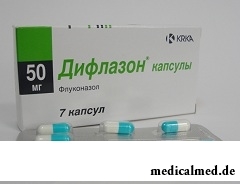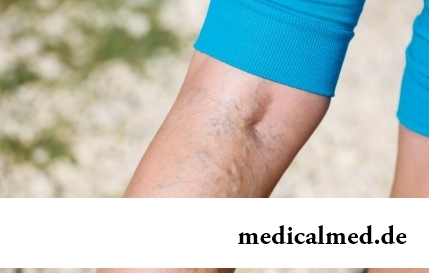





Diflazon
Application instruction:
 Diflazon – antifungal means.
Diflazon – antifungal means.
Form of release and structure
Dosage forms:
- Gelatinous solid capsules: No. 4 – with the white case and a light blue lid, No. 2 – with the white case and a blue lid, No. 1 – with the case and a lid of light blue color, No. 0 – with the white case and a dark-violet lid; capsules contain powder of almost white or white color (No. 4 – on 7 pieces in blisters, in a cardboard pack 1 blister; No. 2 – on 7 pieces in blisters, in a cardboard pack 4 blisters; No. 1 – on 1, 2 or 4 pieces in blisters, in a cardboard pack 1 blister; No. 0 – on 7 pieces in blisters, in a cardboard pack 1 blister, or on 10 pieces in blisters, in a cardboard pack 2 blisters);
- Solution for infusions: transparent colourless liquid, without visible inclusions (on 100 ml in bottles, in a cardboard pack 1 bottle complete with the plastic holder).
Active ingredient of Diflazon – флуконазол:
- 1 capsule: No. 4 – 50 mg, No. 2 – 100 mg, No. 1 – 150 mg, No. 0 – 200 mg;
- 1 ml of solution – 2 mg.
Auxiliary components:
- Capsules: starch corn, lactoses monohydrate, silicon dioxide colloid anhydrous, magnesium stearate, sodium lauryl sulfate;
- Solution: sodium chloride, water for injections.
Structure of a cover of the capsule: gelatin, titanium dioxide (E171).
Besides, in addition as a part of a cover of capsules:
- Capsules No. 4 and No. 2: a cover – dye blue patent (E131);
- Capsules No. 1: the case and a cover – dye blue patent (E131);
- Capsules No. 0: a cover – dyes FD&C indigo carmine an azoruby (E122), blue (E132).
Indications to use
- Generalized candidiasis: a kandidemiya, the disseminated candidiasis, invasive candidosis infections of eyes, respiratory system, a peritoneum, endocardium, uric ways, including at patients of intensive care units, patients with malignant new growths or being on cytotoxic or immunosuppressive therapy, with other factors contributing development of candidiasis;
- Candidiasis of mucous membranes of a mouth (superficial and chronic atrophic candidiasis), drinks, a gullet, noninvasive bronchopulmonary candidiases, a kandiduriya, skin candidiases, including prevention of a recurrence of oropharyngeal candidiasis at patients with AIDS;
- Acute and chronic recurrent vaginal candidiasis;
- Cryptococcal meningitis and other localizations of a cryptococcosis (including skin, lungs), including at various forms of immunosuppression (AIDS, organ transplantation);
- Dermatomycoses, especially at resistance to local therapy of heavy fungal infections of skin, mycoses of smooth skin, a dermatofitiya of feet, scaly (multi-colored) depriving, the sort Candida caused by dermatophytes and mushrooms;
- Prevention of fungal infections at malignant new growths at the patients predisposed to development of such infections as a result of radiation therapy and cytotoxic chemotherapy.
Besides, use of capsules is shown:
- Candidosis balanitis, prevention of a recurrence of vaginal candidiasis in the presence of three and more episodes a year;
- Coccidioidomycosis, deep local mycoses, paracoccidioidomycosis, histoplasmosis, sporotrichosis (at patients with normal immunity);
- Prevention of a cryptococcosis at patients with AIDS.
Also Diflazon's solution is applied to prevention of candidiasis before transplantation of marrow.
Contraindications
- Simultaneous use of a tsizaprid, astemizol or terfenadin (against the background of reception of a flukonazol on 400 mg a day and above) and other means promoting lengthening of an interval of QT and increasing risk of development of the expressed disturbances of a rhythm;
- Breastfeeding period;
- Hypersensitivity to azolny compounds and components of drug.
With care it is necessary to appoint Diflazon: to patients with an invasive, system or superficial fungal infection at emergence of rash against the background of administration of drug; at a liver and renal failure, a combination with terfenadiny the flukonazola in a dose is less than 400 mg in days, potentially proaritmogenny states at the patients who are at the same time accepting medicines, defiant arrhythmias, patients with disturbance of electrolytic balance, organic heart diseases and other risk factors.
Use of a flukonazol during pregnancy is shown only in case of potential threat for the woman's life if the estimated therapeutic effect exceeds harm for a fruit.
Besides, it is contraindicated to children under 3 years to accept capsules.
With care use capsules at intolerance of acetylsalicylic acid.
Under careful observation of the doctor it is necessary to use solution at a hypochlorhydria and an achlorhydria, treatment of children aged up to 6 months and the patients having alcoholism.
Route of administration and dosage
Solution is applied for intravenous (in/in) infusions at patients who cannot accept drug orally. Infusion speed – 200 mg an hour. As soon as there is an opportunity, the patient is transferred to administration of drug inside, without changing a daily dose.
The recommended Diflazon's dosing:
- Cryptococcal meningitis and cryptococcal infections of other localization: in the first days – 400 mg, then in a dose of 200-400 mg of 1 times a day. Usually therapy lasts 6-8 weeks, its duration depends on the clinical effect confirmed with a mycologic research. At patients with AIDS prevention of a recurrence of cryptococcal meningitis carry out in a dose 200 mg a day during the long period;
- System candidiasis: in the first days – 400 mg, then on 200-400 mg of 1 times a day, depending on clinical performance and disease severity increase in a daily dose to 800 mg is possible. Treatment is continued after total disappearance of symptoms of a disease and receiving a negative hemoculture within 2 weeks;
- Candidiasis of mucous membranes: on 50-100 mg of 1 times a day within 1-2 weeks, at patients with an immunodeficiency – 3 weeks. At severe forms of mucous candidiasis appoint 100-200 mg a day. After end of a course of primary therapy at patients with AIDS for prevention of a recurrence it can be appointed флуконазол in a dose of 150 mg once a week;
- Prevention of candidiasis: 50-400 mg a day (depending on weight of a neutropenia and estimated risk of a fungal infection after a miyelotransplantation and/or before cytostatic or radiation therapy at malignant new growths). Flukonazol it is necessary to appoint some days before the expected development of a neutropenia and to continue to apply not less than 1 week after achievement of quantity of neutrophils more than 1000/mm3.
Besides, the dosing mode for capsules (capsules accept inside):
- The atrophic candidiasis of an oral cavity caused by carrying dentures: on 50 mg of 1 times a day within 2 weeks with simultaneous processing of a prosthesis antiseptic agents;
- Vaginal candidiasis: once – 150 mg. For prevention of a recurrence – on 150 mg of 1 times in 4 weeks. Duration of treatment is individual, varies within 4-12 courses;
- The balanitis caused by Candida: once – 150 mg;
- Skin mycosis, including skin candidiasis, mycoses of smooth skin, feet, inguinal area: on 150 mg once a week or on 50 mg of 1 times a day within 2-4 weeks, at mycoses of feet – 6 weeks;
- Chromophytosis: 300 mg once a week, a course of treatment – 2-3 weeks, or on 50 mg of 1 times a day within 2-4 weeks;
- Onychomycosis: 150 mg once a week during the period necessary for full substitution of the infected nail healthy;
- Deep local mycoses: 200-400 mg a day. The estimated duration of therapy at a coccidioidomycosis makes 11-24 months, at a sporotrichosis – 1-16 months, at a paracoccidioidomycosis – 2-17 months, at histoplasmosis – 3-17 months.
To children with candidiasis of mucous membranes drug is appointed in the first day at the rate of 6 mg to 1 kg of weight, then on 3 mg on 1 kg a day.
Children are recommended to appoint Diflazon's dose taking into account weight of a clinical state and the child's weight: at generalized candidiasis and a cryptococcal infection – from 6 to 12 mg on 1 kg of weight of the child a day; for prevention of fungal infections at reduced immunity after cytotoxic chemotherapy or radiation therapy – on 3-12 mg on 1 kg a day.
At the age of 5-13 years the daily dose should not exceed that at adult patients (to 400 mg).
At a single dose of capsules change of a dose with renal failures is not required from patients.
Correction of the mode of dosing is not required to patients of advanced age.
At the clearance of creatinine (CC) less than 50 ml/min. a drug dose at adult patients and children should be lowered depending on degree of a renal failure.
The patients who are on a regular hemodialysis should enter one dose of drug after each session.
Side effects
- Cardiovascular system: lengthening on the electrocardiogram of an interval of QT, trembling or ventricular fibrillation;
- Alimentary system: abdominal pain, nausea, meteorism, vomiting, diarrhea, taste change; seldom – increase in activity of liver enzymes, an abnormal liver function (a hyperbilirubinemia, jaundice, a hepatocellular necrosis, hepatitis), including with a lethal outcome;
- System of a hemopoiesis: seldom – an agranulocytosis, a neutropenia; at heavy fungal infections – thrombocytopenia, a leukopenia;
- Allergic reactions: skin rash, a mnogoformny exudative erythema (including Stephens-Johnson's syndrome), a toxic epidermal necrolysis (Lyell's disease), bronchial asthma (as a rule, at intolerance of acetylsalicylic acid), anaphylactoid reactions, including a skin itch, a face edema, a small tortoiseshell, a Quincke's disease;
- Nervous system: headache, dizziness; seldom – spasms;
- Others: seldom – an alopecia, a renal failure, a hypercholesterolemia, a hypopotassemia, a gipertriglitseridemiya.
Besides, use of solution can cause a loss of appetite and a lock.
Special instructions
Reception of capsules is possible before obtaining results of laboratory analyses, however after their receiving it is recommended to correct the dosing mode.
Treatment by repeated doses of Diflazon has to be followed by control of function of kidneys, at a renal failure it is necessary to appoint the mode of dosing taking into account KK.
It is necessary to make observation of patients with functional disorder of a liver, to regularly monitor the level of liver enzymes. At increase in their activity the doctor has to compare advantage of therapy and risk of possible toxic damage of a liver in a severe form. The hepatotoxic action usually has reversible character and after the therapy termination its symptoms disappear.
At emergence of the rash caused by reception of a flukonazol in patients with a superficial fungal infection drug should be cancelled. At patients with system or invasive fungal pathologies rash it is necessary to observe and cancel therapy in case of a mnogoformny erythema or emergence of violent changes.
At simultaneous use of a flukonazol and anticoagulants of a coumarinic row it is necessary to control a prothrombin time carefully. It is necessary to continue treatment before kliniko-hematologic remission, the premature termination of therapy can lead to a recurrence.
The E122 dye which is a part of capsules No. 0 (200 mg) can cause an allergy, including bronchial asthma.
At patients with intolerance of acetylsalicylic acid allergic reactions appear more often.
Negative influence of Diflazon on ability of the patient to control of vehicles and mechanisms is not established.
Medicinal interaction
During treatment by Diflazon simultaneous use of any medicines needs to be coordinated with the attending physician.
Terms and storage conditions
To protect from children.
To store at a temperature: capsules – to 25 °C, solution – to 30 °C.
Period of validity: capsules – 5 years, solution – 3 years.
Average life expectancy of lefthanders is less, than right-handed persons.

A lot of things depend on a condition of a backbone in a human body, a backbone - not only a support for a body, it also contain...
Section: Articles about health
The varicosity has familiarly many, statistically, this disease more than a half of all adult population. As a rule, the varicosis affects preferential superficial vessels, and is shown by characteristic cosmetic defects. Guo...
Section: Articles about health
Food with the increased content of sugar is attractive to most of people - it is scientifically confirmed fact. Business here not in intemperance or dissoluteness: the sweet food is associated since childhood with feeling of rest and safety which tests the kid when it absorbs maternal milk. Besides, getting into a human body, sugar strengthens production of "happiness hormones" which all of us so need. And still life of sweet teeth seldom happens cloudless: their too big loss...
Section: Articles about health
Proofs of efficiency of Mildronate at treatment of coronary heart disease with stenocardia can be found in many publications to...
Section: Articles about health
History of mankind contains several tens of epidemics whose emergence was compared by eyewitnesses and historians to doomsday. The most terrible of them claimed the lives of millions of people, having made even the whole people to the person of the earth. What they − the diseases striking terror? Daringly...
Section: Articles about health
The phenomenon of improvement of a condition of the patients at administration of drugs who are not containing active agents, so-called effect of placebo is known long ago. At the end of the 18th century the American doctor Perkins began to treat people the "miracle" sticks made of alloy of steel and brass. Was for several minutes to press such subject enough to a sore point that it became much easier for the patient. Having suspected Perkins of charlatanism, his colleagues tried to repeat "miracle" by means of sticks, steles...
Section: Articles about health
Small appetite at the child – the complaint which pediatricians should hear practically from each mother. Most often it is carried to разр...
Section: Articles about health
Life activity of one-celled fungi of the sort Candida, related to yeast is a proximate cause of development of candidiasis (milkwoman). Normal these microorganisms are a part of the microflora living in an oral cavity and intestines of most of people, and that...
Section: Articles about health
Eyes – one of the most vulnerable areas on a face therefore age changes concern them first of all. Whether it is possible to keep look youth for many years and what procedures are offered for achievement of this purpose by cosmetologists? And maybe, the only option of rejuvenation is surgery – a blepharoplasty? Let's try to understand this question....
Section: Articles about health
About influence of fasting days on an organism it is told much – both about advantages, and about shortcomings. It is considered that fasting day...
Section: Articles about health
Osteoporosis this general disease which main sign is decrease in density of a bone tissue. On distribution width it takes the fourth place among noninfectious diseases. The illness develops at mature age more often: in our country to them harvest seasons...
Section: Articles about health
Traveling all over the world, many try to try the most exotic dishes of national cuisines. There is even a so-called gastronomic tourism which, according to gourmets, not only allows to receive new feelings, but also is capable to show life of other people from absolutely unexpected side....
Section: Articles about health
More than a half of the married couples which faced prostatitis – leave. The new broadcast "Female View of Prostatitis" will help to learn...
Section: Articles about health
The person, as well as all other beings living on our planet feels weather changing. It is the normal meteosensitivity which is not causing to healthy people of special troubles. Meteodependence, on the contrary, is morbid condition, характеризующимс...
Section: Articles about health
Statistically, at the address to doctors seven of each ten patients complain of a headache. Actually it is much more people who are periodically feeling unpleasant feelings such. Many people, apart from a headache the reason for serious fears, prefer to muffle independently the next attack medicines. Such behavior is extremely careless, especially if this symptom appears regularly and is followed by other signs of an indisposition. Constants head Bol...
Section: Articles about health
So, you resolved to lose weight. And now you try to understand what to begin with: from exercise stresses or a diet? And how to make, h...
Section: Slideshow
Ability of an organism to resist to adverse environmental factors (to impact of temperature drops, humidity and pressure, to the attacks of causative organisms, etc.) directly depends on what the person eats. Business here not only in, that C...
Section: Articles about health
Frosty air, fresh wind and easy snowball at most of Russians are associated with cheerfulness, health and cheerful entertainments on which our winter is so generous. But, unfortunately, cold season sometimes brings also troubles with health. It is not about seasonal colds and frostbites, and about those chronic illnesses which symptoms are shown preferential in the winter....
Section: Articles about health
Summer in the heat. Many are going to spend vacation abroad. Travelers the tender seas, rest on beaches wait, for survey достоп...
Section: Articles about health
The next flu epidemic leads to the next panic, from year to year we give in on these manipulations: professionally alarming voice of the announcer in news, reports with calculation of the died patients, an interview with people in white dressing gowns and advertizing of anti-influenza means ра...
Section: Articles about health
What they, women? Beautiful, gentle, passionate and at the same time windy, gusty, and nervous. And what is stranger: have all these qualities of the woman at the same time. But here only the mood their time sharply changes on completely opposite: in the morning they laugh and joke, and in the evening cry or are irritated....
Section: Articles about health
It would seem, to buy drugs in Moscow does not make a problem – a drugstore, and not one, is available for each resident of the capital in step a toast...
Section: Articles about health
Statistically, pathologies of a thyroid gland in the world more than 500 million people have. Failures in work of this body lead to heavy disbolism, development of heart diseases, vessels, a reproductive and nervous system. In hard cases excessive...
Section: Articles about health
Ayurveda - the most ancient tselitelsky practice which came to us from India. It represents the doctrine about maintenance of physical, psychological and moral health of the person by means of the complex of procedures including a diet, cleaning of an organism, breathing exercises, massage, and in case of a disease - and medicinal therapy. The healers practicing Ayurveda assign very important part to spices, and at the heart of Ayurvedic drugs, as a rule, there are they. It is considered that spices not of t...
Section: Articles about health
For the time being the perspective of heart diseases seems to most of people remote and foggy. But sooner or later практичес...
Section: Articles about health
All got used long ago that, having addressed the plastic surgeon, it is possible to modify natural parameters of a figure or to minimize the damages put to appearance with ruthless time. Many people (preferential women) worldwide е...
Section: Articles about health

